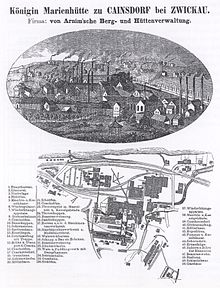Queen Marienhütte
The Queen Marienhütte (also Queen Marienhütte and Queen Marien Hut , popularly also simply hut ) was an important Saxon ironworks in Cainsdorf near Zwickau in the Saxon district of Zwickau .
history
The Queen Marienhütte (named after the Saxon Queen Maria ) was founded on August 2, 1839 by the Saxon Iron Company . The proximity to the Zwickau hard coal depots was decisive for the choice of location . The raw materials were largely obtained from local sources: coke from the Planitz coal works, iron ore from the treasure trove for the newborn child in Stenn , lime as an additive from Planitz . The founding of the smelter in Saxon iron smelting marks the transition from charcoal- fired blast furnaces to coke or hard coal as fuel.
The first blast furnace was blown in 1842. In 1843 the brothers Georg Heinrich Wolf , Friedrich Henning and Hans Carl von Arnim leased the plant. In 1844 a puddle and rolling mill was introduced. From 1848 railroad tracks were manufactured in the hut . In 1849 a steam hammer was set up and the company was subsequently expanded to include a mechanical engineering company and a pipe foundry. Around 1850 the company employed around 1200 workers, this number rose to around 1800 by 1865. After the steel construction began to build bridges , the Deutsche Reichs- und Continental-Eisenbahnbau-Gesellschaft acquired the company in 1873. The steel products were mostly marked with the abbreviated company logo “K. M. H. "provided.
In 1892 it was called the "largest ironworks in Saxony with 1750 workers, 4 blast furnaces, 2 foundries, rail and fine iron rolling mill, Bessemerstahlhütte , important bridge-building workshop , mechanical engineering company, etc." With the drying up of the ore reserves from the surrounding area, pig iron smelting in the blast furnace was stopped in August 1893. This ended the block delivery contract that Maxhütte (Unterwellenborn) , a Thuringian branch of Maximilianshütte founded in 1872 in Sulzbach-Rosenberg in Upper Palatinate , had with Königin-Marienhütte. The general director of the Maxhütte in Rosenberg decided to build a steel mill with an attached rolling mill on the area south-west of the Zwickau main station , which at that time belonged to the municipality of Lichtentanne . Known as the König-Albert-Werk , this steelworks in the Maxhütte district, which today belongs to Zwickau, was in operation between 1898 and 1930.
From 1916 to 1945 Queen Marienhütte was owned by Sächsische Gussstahlwerke Döhlen AG . It was at that time only 50 workers in Weichenbau busy.
Until the political turnaround in 1990, the former Queen Marienhütte was part of the Soviet-German stock corporation Wismut as Operation 536 . The company for mining and processing plants Cainsdorf (BAC) of SDAG Wismut, which began producing under the new name in 1968, then became the property of the Federal Ministry of Economics in 1990 and was spun off as DFA GmbH (German manufacturing and plant construction) in 1992/93. Production took place in steel and container construction, in conveyor technology, in building material machines, in room containers and in industrial assembly. With the privatization in 1995 up to its insolvency in 2004, the successor company operated as SAM GmbH (Saxon Plant and Mechanical Engineering). In 2005, ZSB GmbH (Zwickauer Sonderstahlbau) took over the SAM production facilities as part of an acquisition concept. With the integration of permanent staff, the tradition in steel construction is continued. Today there are around 60 employees.
Received evidence of production history

The steel parts of the following structures were manufactured in the Queen Marienhütte (selection):
- Roof structure of the St. Petrikirche in Chemnitz
- Markersbach Viaduct on the Annaberg-Buchholz-Schwarzenberg railway line
- Railway Elbe Bridge in Riesa
- Carolabrücke on the Bautzen – Bad Schandau railway line in Bad Schandau
- Muldenbrücke in Trebsen (1000th bridge of the Queen Marienhütte)
- Blue Wonder in Dresden (1500th bridge of the Queen Marienhütte)
- Paradise Bridge in Zwickau
- Beckerbrücke viaduct in Chemnitz
- Sayda water tower
- Viaduct Oschützal
Personalities
- Eugen Piwowarsky (1891–1953), materials scientist and foundry specialist, was an assistant at the Queen Marienhütte
literature
- O. Neubert: The Queen Marienhütte in Cainsdorf . in: Sächsische Pestalozzi-Vereine (ed.): Colorful pictures from the Sachsenlande , Volume II, Verlag Julius Klinkhardt, Leipzig 1898, pp. 385–389
- Eckert & Pflug (ed.): The large-scale industry of the Kingdom of Saxony in words and pictures: a gift of honor for Se. Majesty King Albert of Saxony. Leipzig , Volume 1, 1892 ( digitized version )
- Hubert Treger: The Queen Marienhütte Cainsdorf / Sa. from 1839 to 1945 , Zschiesche: Wilkau-Haßlau, 2014. ISBN 978-3-9815145-7-5
- Hubert Treger: The change in a traditional steel and mechanical engineering site in Cainsdorf from 1945 to the present , Zschiesche: Wilkau-Haßlau, 2014. ISBN 978-3-9815145-5-1
- Norbert Peschke : The history of the Queen Marienhütte and other iron works in Zwickau . Zschiesche GmbH, Wilkau-Haßlau 2019, ISBN 978-3-9817878-2-5 .
- Norbert Peschke: Die Königin-Marienhütte Cainsdorf , in: Sächsische Heimatblätter 66 (2020), Issue 2, pp. 129-143. ISSN 0486-8234
Web links
- Literature by and about Queen Marienhütte in the Saxon Bibliography
- Short site history (ZSB Zwickauer Sonderstahlbau GmbH)
- Queen Marienhütte Actien-Gesellschaft , private website
Individual evidence
- ^ Zwickauer Sonderstahlbau GmbH - Bridge construction on the Brückenberg. In: zsb-sonderstahlbau.de. January 8, 2015, accessed March 4, 2017 .
- ^ Meyers Konversationslexikon, author collective, Verlag des Bibliographisches Institut, Leipzig and Vienna, fourth edition, 1885-1892, keyword Kainsdorf (Cainsdorf)
- ↑ The König-Albert-Werk on www.albert-gieseler.de
Coordinates: 50 ° 41 ′ 0.4 ″ N , 12 ° 29 ′ 59.3 ″ E




